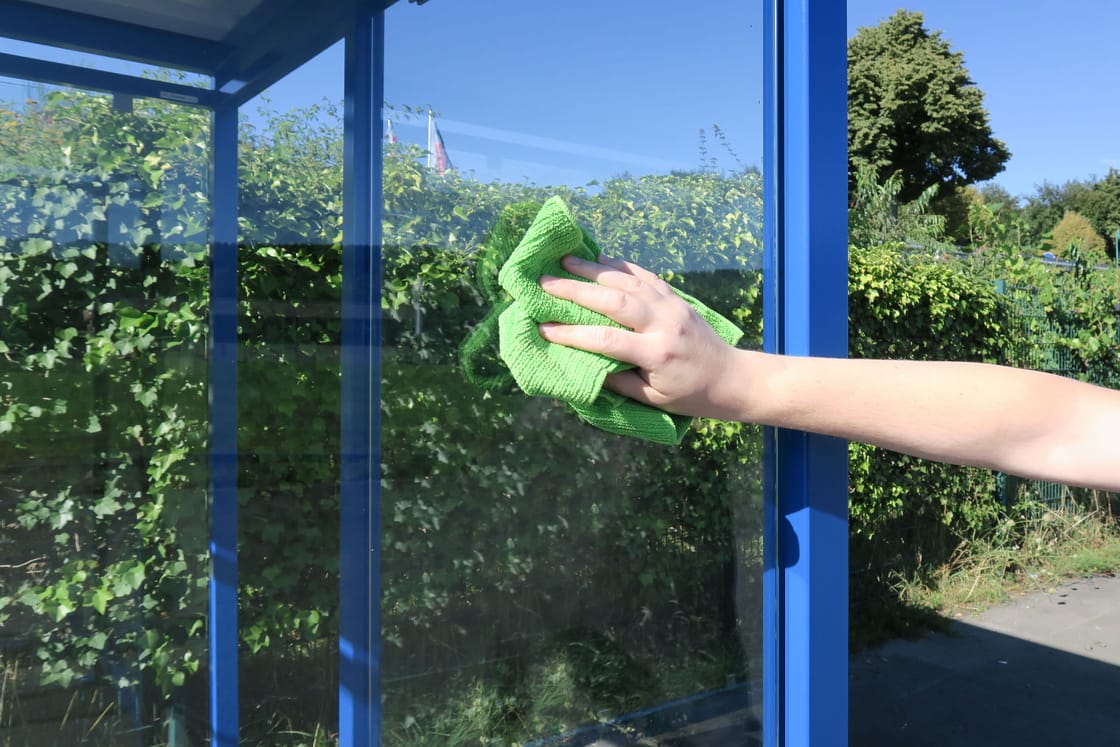Like new even after many years – roofing care
Once a month through the car wash – with canopies, passenger and smoking shelters, unfortunately, this is not possible. Regular care, however, also contributes to good looks and value retention here, and just as with automobiles, attention must also be paid to material sensitivities. If you do everything right and do not take too much time with the intervals, you will enjoy your building and its equipment for many years. However, replacement is often the only way to prevent deliberate damage.
Durable ex works
Canopies, bus shelters and smoking shelters can be made to be extremely sturdy and durable. Hot-dip galvanized metal, perfect welds, industrial-grade paint, and high-quality glass, wood, and plastic elements guarantee long durability. It can be increased even further by regular maintenance of the components.
During the inspection, which is best to “do” every spring and fall, first of all, the drainage channels should be inspected and cleaned of moss and dirt. Clogged gutters direct rainwater uncontrollably possibly onto walls or into the occupied area, and this can be easily avoided. The same applies to the accessible surfaces of the ceiling elements.
Glass surfaces and ceiling sheets should also be cleaned inside and out on this occasion. The steel frame structure can withstand wind and rain permanently, but cleaning the surfaces especially from road salt or chemicals from agriculture, saves them from possible damage. Ashtrays should also be emptied and cleaned more often, depending on usage.
The gentle way
High-pressure cleaners are convenient, but can cause irreparable damage to paintwork, glass and wooden parts. The same applies to additives or cleaning substances for cleaning. Pure water will do. For stubborn stains, largely neutral cleaning agents or commercially available glass cleaners can be used as a support. Soiling with grease or sealant residues may be removed with commercially available solvents such as methylated spirits or isopropanol.
As a rule, glass surfaces should always be cleaned with plenty of clean water to avoid abrasive effects caused by dirt particles. Suitable hand tools include soft, clean sponges, leather, rags or rubber scrapers. The use of pointed, sharp metallic objects could damage the surface.
In principle, any aggressive contamination (e.g. concrete and cement slurries, plasters, mortars) must be avoided. Should this occur, the soiling must be washed off immediately after occurrence with non-aggressive agents and plenty of clean water without leaving any residue.
Chemical cleaning agents such as alkaline lyes, acids or fluoride-containing agents as well as cleaners with abrasive components are taboo. These can permanently attack the surface of the glass (printed or unprinted). The same applies to many plastics.
If you want to protect wood from wood-destroying organisms and weathering, you can’t avoid regular maintenance coats. It is best not to wait for weathering to expose the surface of the wood. The suitable maintenance intervals depend on the weather exposure, the external stress and, in the case of glazes, on the color shade used. Light shades shorten the maintenance interval. Inspections and, if necessary, recoating are recommended more frequently with glazes than with opaque coatings.
Damaged areas must be repaired as quickly as possible to prevent moisture infiltration and the resulting spalling of the coating. For an initial touch-up, a care milk can be used for this purpose. Even slight surface damage such as cracks are protected by this. The care balm penetrates into the coating and thus seals against further water absorption. Just one coat twice a year can significantly extend the intervals between renovations. At the same time, the color effect and shine is refreshed.
A care set of wood cleaner and care balm does a good job. The surfaces should be cleaned with warm, clean water and then with wood cleaner. Then spread the care balm with soft and non-fibrous cloth. Then wipe lightly with a damp cloth and you’re done!
What to do about graffiti?
If you want to destroy something at all costs, you will succeed. Far more common than such extreme interventions, however, are graffiti – creative treatments of glass, wood and metal surfaces through scratchings or applications of paint. If sharp-edged objects are used for scoring, the damage is irreparable, depending on the depth – in the case of plastics and glass, the only option is to replace the affected parts.
Metal surfaces can possibly be treated with a special “killer gel” that Bahn AG is already using successfully on its trains. The manufacturer will tell you whether a coating can withstand this.
